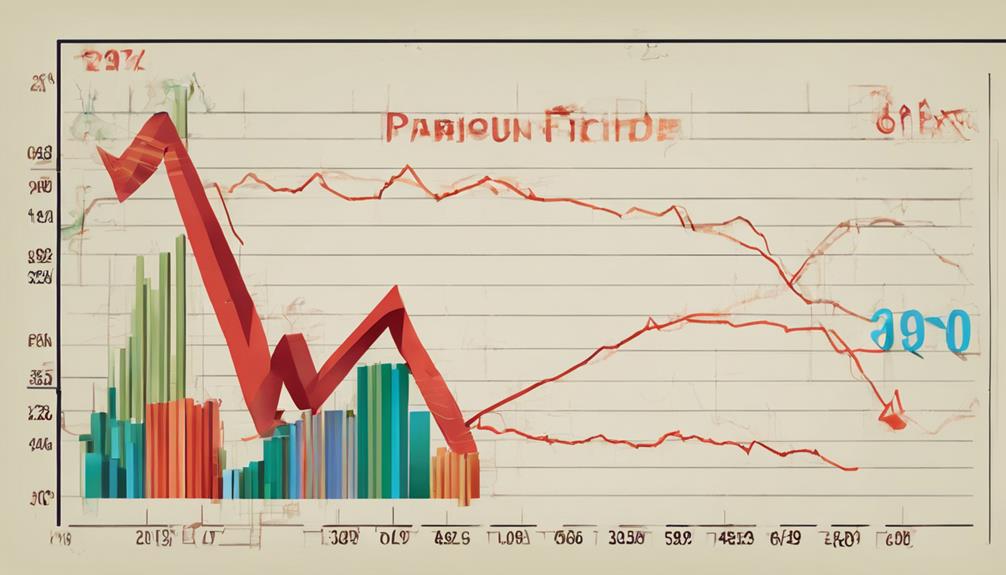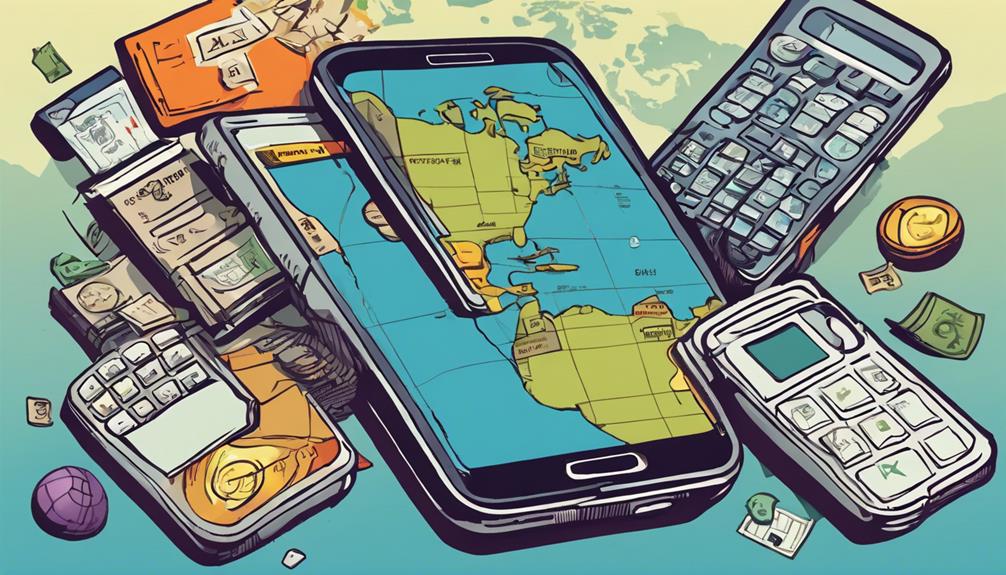Global investors, focus on Real GDP, Labor Market Indicators, and Inflation Indexes. Monitor Consumer Confidence, Retail Sales Data, and Business Cycle Phases. Understand Financial Market Impact and Economic Indicator Types. These indicators offer valuable insights for informed investment decisions and maneuvering the global economy.
Key Takeaways
- Real GDP reflects economic health and growth.
- Labor market indicators show employment trends and strength.
- Inflation indexes predict price changes impacting consumers and producers.
- Consumer confidence signals market behavior and growth.
- Retail sales data influences market sentiment and investor decisions.
Real GDP

Real GDP, an important measure in economics, quantifies the total value of goods and services produced in the U.S. adjusted for inflation. Reported quarterly by the U.S. Department of Commerce's Bureau of Economic Analysis, Real GDP serves as a vital indicator of economic health and growth.
By analyzing Real GDP, investors gain valuable insights into the overall performance of the economy. The components of Real GDP, including consumer spending, government expenditures, investments, and net exports, collectively contribute to the calculation of this key metric.
Changes in Real GDP over time help identify economic expansions and contractions, providing a clear picture of the country's economic trajectory. Understanding the fluctuations in Real GDP is essential for making informed investment decisions and gauging the strength of the economy.
Labor Market Indicators

To gain a thorough understanding of economic performance and investment opportunities, you should now focus on Labor Market Indicators, specifically Nonfarm Payrolls and the Unemployment Rate. These indicators are essential for evaluating the health of the labor market and making informed investment decisions.
Here are key points to keep in mind:
- Nonfarm Payrolls: Reflecting the total number of workers employed by U.S. businesses, Nonfarm Payrolls are a significant gauge of labor market strength. Investors track these numbers closely to analyze employment trends and anticipate shifts in consumer spending.
- Unemployment Rate: The Unemployment Rate measures the proportion of the labor force that's unemployed. A lower rate signifies a healthier job market, impacting interest rates and overall economic performance. Understanding changes in this rate is crucial for predicting market movements.
- Bureau of Labor Statistics: Both Nonfarm Payrolls and the Unemployment Rate are released monthly by the Bureau of Labor Statistics, providing up-to-date insights into the job market's dynamics.
Inflation Indexes

Understanding inflation indexes like the Consumer Price Index (CPI) and the Producer Price Index (PPI) is essential for evaluating economic health and making well-informed investment decisions.
The CPI measures changes in prices paid by consumers for goods and services, providing insight into inflation trends affecting the average consumer.
On the other hand, the PPI reflects price changes from the seller's perspective, indicating potential future inflation in the production pipeline.
By tracking these inflation indexes, investors can anticipate how price changes for goods and services may impact both consumers and producers.
Monitoring these indicators is critical for evaluating economic health and predicting potential shifts in the market.
Keeping a close eye on inflation indexes like CPI and PPI can help you make strategic investment decisions based on a thorough understanding of how price fluctuations influence the overall economy.
Consumer Confidence

You need to understand how consumer confidence impacts markets, influences trends in consumer sentiment, and shapes economic behavior.
High consumer confidence often signals increased spending, which can drive economic growth and impact various sectors.
Keep an eye on consumer confidence indicators to gauge the overall health of the economy and potential market shifts.
Confidence Impact on Markets
Consumer Confidence plays a pivotal role in influencing market behavior and investor decisions worldwide.
When appraising the impact of consumer confidence on markets, consider the following:
- Consumer Confidence Index: This key economic indicator reflects consumer sentiment about the economy and future prospects. A high index often indicates increased consumer spending and can positively affect stock market performance.
- Economic Growth and Stability: Strong consumer confidence levels can signal economic growth and stability. Global investors closely monitor these levels as they provide valuable insights into consumer behavior and overall economic health.
- Economic Uncertainty: Conversely, low consumer confidence levels may suggest economic uncertainty. Such fluctuations in consumer sentiment can have significant implications for various sectors of the economy, making it imperative for investors to stay informed and adapt their strategies accordingly.
Consumer Sentiment Trends
High consumer sentiment trends, such as those showcased in the Consumer Confidence Index released monthly by The Conference Board, play a pivotal role in shaping market dynamics and investor decisions globally. The Consumer Confidence Index reflects consumer attitudes towards the economy, future expectations, and influences consumer spending patterns and economic health.
Understanding consumer sentiment trends is key as it can impact stock market performance, corporate earnings, economic stability, and even predict potential market shifts. High consumer confidence levels often lead to increased spending and investment, which in turn fuels economic growth.
Monitoring consumer sentiment trends provides valuable insights into consumer behavior, economic stability, and helps investors anticipate future market conditions. By keeping an eye on the Consumer Confidence Index and consumer sentiment trends, investors can make more informed decisions and adapt their strategies accordingly to navigate the ever-changing global market landscape.
Economic Behavior Influence
Regularly monitoring consumer confidence indexes provides vital insights into how consumer sentiment influences economic behavior and market dynamics. Consumer confidence is an essential factor in shaping economic activity and stability.
Here's how it impacts various aspects:
- Boosting Economic Growth: High consumer confidence levels often lead to increased spending, driving economic growth through enhanced consumer participation in the market.
- Impacting Stock Market Performance: Positive consumer confidence can have a ripple effect on the stock market, as heightened consumer optimism may translate into higher investments and improved market performance.
- Influencing Consumer Behavior: Consumer confidence plays a significant role in shaping consumer behavior, affecting decisions related to major purchases and investments, thereby influencing overall economic activity.
Retail Sales Data

You rely on retail sales trends to gauge consumer spending behavior and its impact on markets. Understanding these patterns helps you assess economic health and make informed investment decisions.
Keep a close eye on retail sales data as it plays a pivotal role in shaping market dynamics and investor sentiment.
Retail Sales Trends
Tracking retail sales trends provides valuable insights into consumer behavior and economic conditions for global investors. Retail sales data, which measures the total sales of retail establishments monthly, is a key indicator of consumer spending and the overall health of the retail sector.
Here are three essential points to keep in mind when analyzing retail sales trends:
- Market Sentiments:
Retail sales data heavily influences market sentiments, as strong sales growth can boost investor confidence, leading to an increase in stock prices. Conversely, weak retail sales figures may raise concerns about economic challenges, impacting market sentiment negatively.
- Consumer Behavior:
Monitoring retail sales trends helps investors understand changing consumer behavior patterns. By examining what consumers are purchasing and how much they're spending, investors can make more informed decisions regarding their investments.
- Investment Decisions:
Analyzing retail sales trends plays a significant role in shaping investment decisions. Investors often use retail sales data as an essential factor when determining where to allocate their funds, as it provides insights into the overall economic landscape.
Impact on Markets
Understanding how retail sales data impacts markets is essential for global investors seeking to make informed investment decisions.
Retail sales data is a vital indicator of economic activity, reflecting consumer confidence and overall economic health. Strong retail sales figures often correlate with higher stock market performance and increased company revenues.
Global investors closely watch retail sales data as it provides insights into market trends and helps in predicting GDP growth. A rise in retail sales can signal a thriving market, leading to positive investor sentiment and potentially driving stock prices up.
Conversely, a decline in retail sales may indicate economic challenges, causing market volatility and impacting investment decisions. By analyzing retail sales data, investors can better understand consumer behavior, make strategic investment choices, and stay ahead of market fluctuations.
It is essential for global investors to monitor retail sales data to navigate the complexities of the market effectively.
Consumer Spending Behavior
Retail sales data provides important insights into consumer spending behavior, reflecting economic health and consumer confidence. By analyzing this data, you can stay informed about market trends and identify potential investment opportunities.
Here are three key points to keep in mind:
- Consumer Spending: Retail sales data tracks the amount consumers spend at retail stores and online, giving a detailed picture of consumer activity. Understanding consumer behavior is vital for predicting economic trends.
- Economic Health: Strong retail sales figures often indicate a healthy economy with increased consumer confidence. Monitoring retail sales data can help you assess the overall economic well-being of a country or region.
- Investment Opportunities: By keeping an eye on retail sales data released monthly by the U.S. Department of Commerce, investors can spot emerging trends and capitalize on potential investment opportunities in sectors impacted by consumer spending patterns.
Business Cycle Phases

During the course of economic cycles, various phases such as expansion, contraction, peak, and trough serve as significant indicators of the overall health of an economy.
In the expansion phase, employment levels typically increase, along with consumer spending, reflecting a growing economy.
Conversely, contraction phases show declining employment rates and reduced consumer confidence, indicating an economic slowdown.
Peaks in the business cycle represent the highest point of economic activity before a downturn, signaling a potential shift towards contraction.
On the other hand, troughs mark the lowest point in the business cycle, often prompting central banks to implement interest rate cuts to stimulate economic growth.
Understanding these business cycle phases is essential for investors as they provide insights into the current state of the economy and can help anticipate future trends, guiding investment decisions accordingly.
Financial Market Impact

In the world of global investing, the impact of key economic indicators on financial markets is significant and far-reaching. When monitoring these indicators, keep in mind the following:
- Stock markets: Strong GDP growth and high consumer confidence often lead to stock market rallies. Conversely, downturns in these indicators may result in market declines.
- Bond markets: Changes in interest rates heavily influence bond markets. In an expanding economy, bond prices may decrease due to rising interest rates, while in a contracting economy, bond prices might rise as interest rates fall.
- Leading indicators: Keep an eye on leading indicators like the S&P 500 and Purchasing Managers' Index (PMI) for insights into future economic trends. These indicators can provide valuable information that impacts financial markets, allowing investors to make informed decisions and adjust their strategies accordingly.
Understanding how these indicators affect financial markets is crucial for navigating the complexities of global investing.
Economic Indicator Types

Various kinds of economic indicators play a vital role in providing insights into different aspects of economic trends and conditions for global investors. Leading indicators, like the Consumer Sentiment Index and stock market performance, offer a peek into future economic trends, helping investors anticipate potential market movements.
Coincident indicators, such as Nonfarm Payrolls and GDP, provide a real-time snapshot of the current economic status, aiding investors in making informed decisions based on the present economic conditions.
Conversely, lagging indicators like the Unemployment Rate and Consumer Price Index offer historical context to economic trends, allowing investors to assess the impact of past events on the market.
Understanding these economic indicator types is essential for making well-informed investment decisions. By analyzing a combination of leading, coincident, and lagging indicators, investors can gain a thorough understanding of economic trends and their implications for the market, ultimately enhancing their ability to navigate the complexities of the global economy.
Frequently Asked Questions
What Are the 5 Important Economic Indicators?
When learning about economic indicators, remember the five key ones: GDP growth rate, unemployment rate, inflation rate (CPI), consumer confidence index, and retail sales data. These factors impact investment decisions and market trends.
What Economic Indicators Do Investors Prize the Most?
Like a seasoned captain steering turbulent seas, you rely on GDP growth, nonfarm payrolls, unemployment rates, and more to guide your investment ship. These key indicators illuminate economic trends and guide your decisions.
Which Economic Indicators Are Most Important?
When evaluating economic indicators, focus on GDP growth rate, nonfarm payrolls, unemployment rate, consumer confidence, and retail sales. These metrics provide valuable insights for global investors, aiding in decision-making and trend analysis for informed investment strategies.
What Is the #1 Economic Indicator for a Nation's Economy?
For a nation's economy, the #1 economic indicator is Gross Domestic Product (GDP). It measures the total value of goods and services produced within a country, reflecting economic health and influencing investment decisions worldwide.
Conclusion
As a global investor, keeping a close eye on key economic indicators is essential to making informed decisions. By monitoring:
- Real GDP
- Labor market indicators
- Inflation indexes
- Consumer confidence
- Retail sales data
- Business cycle phases
- Financial market impact
You can stay ahead of the game.
Remember, knowledge is power in the world of investing, so stay informed and watch these indicators closely for potential opportunities and risks.
Happy investing!









